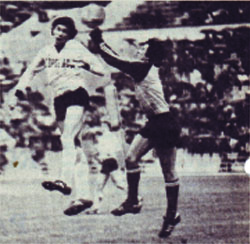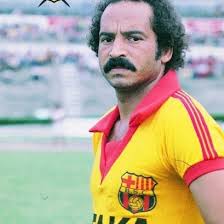South American player of the year was voted Diego Maradona – like in the year before. Perhaps now there was no doubt – Diego was already around for awhile and truly established star – not just a promising talent credited more for the future than for the present. Waldemar Victorino (Nacional,Uruguay) was 3rd and his case was clear – great year for him, but largely because of Nacional’s international victories. Zico (Flamengo) was 2nd – he was ranked high for consistent strong playing, not that much for any outstanding international game or two. Maradona was like Zico – Argentinos Juniors became familiar name outside Argentina not because they were great team, but because of Maradona – and largely thanks to him they became a strong factor in Argentine football, however, unable to win a title. 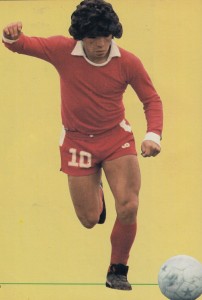
African Player of the Year
African Player of the year was voted Jean Manga-Onguene. Second was Segun Odegbami (Shooting Stars, Nigeria) and third -one more Cameroonian, Theophile Abega (Canon). Tradition was continued – except Salif Keita in 1970, no European based player appeared among the top 3 of Africa. Domestic players and even more – only Abega of the top 3 this year eventually played in Europe. The top spent their entire careers at home. Technically, playing amateur football. As ever, international results mattered most – Manga-Onguene and Abega won the African Champions Cup, Odegbami became champion of Africa with Nigeria and played at the Olympic games in Moscow too. There will be always the question were journalists more impressed by one or two important matches than from a whole regular season? Odegbami at least was Nigerian legend, but Abega? Considering that his teammate Thomas N’Kono was out of the top 3 for the first time in three years. Anyhow, those were voted the best and in the case of the winner it was well-deserved first place.
Jean Manga-Onguene was born in 1946, debuted in 1966, and played his whole career for Canon (Yaounde). Eventually, he became one of the best know African players, which was particularly important recognition since he never played in Europe. Prolific striker and key figure for both his club and the national team of Cameroon for 15 years – a true star. A star on continental scale. And it was not a case of just a recognizable player – Manga-Onguene was already 5 times champion of Cameroon, 6 times cup winner, had 3 African Champions Cups and 1 Cup Winners Cup. He was more than instrumental for the success of Canon in the 1970s. Was 1980 – when he was 34 – his best year is questionable, but he was still a winner and a key player. If anything, he deserved to be voted number 1 in Africa more than some other guys crowned earlier. The only thing missing in his impressive career was a World Cup – unfortunately, Cameroon qualified only in 1982 and Manga-Onguene was no longer playing then. But even this success happened – to a point – because of him: he was still a national team player in 1980: the heroes of 1982 grew up along him and inspired by him.
African Cup Winners Cup
The Cup Winners Cup had a bit more incidences than the Champions Cup – two clubs withdrew without playing at all: Ader Club (Niger) and Dingareh (Gambia). Strangely, the club benefiting from Ader Club’s withdrawal did the same in the next round – Esperance (Tunisia) left the tournament without playing a single match. No luck for the Cameroonian represent: Dynamo (Douala) qualified directly to the second round, thanks to a bye, but there they faced Eleven Wise of Ghana. More or less, Ghana was one of the consistently strong African nations and Eleven Wise prevailed over the Cameroonians 2-1 and 1-1. Meantime, the Zairian representative, TP Mazembe, was going as well as their compatriots in the Champions Cup – the first loss and first difficulties they had in the ¼ finals. Shooting Stars of Ibadan, Nigeria, was traditionally strong opponent and perhaps even more so in the year of rising Nigerian football. TP Mazembe still won the penalty shoot-out, though. They had easy – on paper – opponent at the semi-finals: Kadiogo (Upper Volta, today – Burkina Faso). It should have been a walk in the park, but it was not – Mazembe won only 1-0 at home and extracted a 2-2 tie away. The other semi-final was tough: Africa Sports (Cote d’Ivoire) vs MA Hussain-Dey (Algeria), two of the better African clubs. Africa Sports won 1-0 at home and survived Algerian assault in the second leg, tying the match 2-2. Africa Sports and TP Mazembe contested the Cup Winners Cup. The winner was really decided in the first leg in Algeria – Mazembe won 3-1, making the second match a mere formality. They won it too, only the result was minimal – 1-0. TP Mazembe won their first Cup Winners Cup!
 Africa Sports of Abidjan are one of the two strongest Cote d’Ivoirean clubs, but internationally they did not win anything for a long time. 1980 was perhaps their first real attempt to conquer Africa, but they failed. Reaching the final was great, though.
Africa Sports of Abidjan are one of the two strongest Cote d’Ivoirean clubs, but internationally they did not win anything for a long time. 1980 was perhaps their first real attempt to conquer Africa, but they failed. Reaching the final was great, though.
 TP Mazembe won their first Cup Winners Cup, but it was just one trophy to them – back in 1960s they won the Champions Cup twice: 1966 and 1967. Back then they were named Englebert – named after their sponsor, a tire brand. The original name of the club was Saint Georges – since the club was founded by Benedictine monks. After the Ravens (as the club is nicknamed) won 3 consecutive titles, in the 1966 Tout Puissant (Almighty) was added to the official name. By 1980 the name was TP Mazembe – today more history is recognized, so the current name includes Englebert too. As for the team hailing from Lubumbashi… hard to tell.
TP Mazembe won their first Cup Winners Cup, but it was just one trophy to them – back in 1960s they won the Champions Cup twice: 1966 and 1967. Back then they were named Englebert – named after their sponsor, a tire brand. The original name of the club was Saint Georges – since the club was founded by Benedictine monks. After the Ravens (as the club is nicknamed) won 3 consecutive titles, in the 1966 Tout Puissant (Almighty) was added to the official name. By 1980 the name was TP Mazembe – today more history is recognized, so the current name includes Englebert too. As for the team hailing from Lubumbashi… hard to tell.
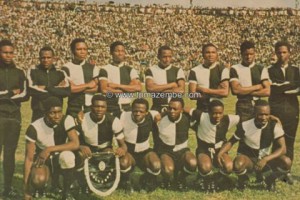 TP Mazembe 1980 – is there a goalkeeper at all?
TP Mazembe 1980 – is there a goalkeeper at all?
 Or may be these are our boys? Nice and rare kit – the picture very likely is not from the final against Africa Sports, but it is worthy showing just for the design. The Ravens excelled not only by playing – their kits are great.
Or may be these are our boys? Nice and rare kit – the picture very likely is not from the final against Africa Sports, but it is worthy showing just for the design. The Ravens excelled not only by playing – their kits are great.
African Champions Cup
Africa was almost unnoticed in 1980, but football was played, of course. At a glance, international football was less disorganized and chaotic than before. Only 2 clubs withdrew from the African Champions Cup – Limbe Leaf Wanderers (Malawi) and Comercial Bank (Uganda). All other participants played and the tournament was played without visible scandals. Cameroon was represented by 2 teams – Union (Douala) as African Cup holders and Canon (Yaounde) as champion of the country. Both reached the semi-finals, proving once again the superiority of Cameroonian club football. The other two semi-finalists represented old power and emerging new one: AS Bilima (Zaire) and Bendel Insurance (Nigeria). AS Bilima eliminated Union (Douala) – 0-1 and 5-1 at home, but Bendel Insurance was unsuccessful against Canon – they managed a 0-0 tie in Yaounde, but were destroyed 2-4 in front of their home crowd. So, the final was between Canon and AS Bilima. On November 30 Canon struggled, hosting the first leg of the final – 2-2 at their stadium Militaire Garoua, Yaounde. Like in the semi-final, Canon was stronger visitor than host – on December 14 AS Bilima had no chance at 20th May Stadium in Kinshasa. Canon destroyed them 3-0! And won their 3rd African Champions Cup!
AS Bilima is a bit of a mystery – the club is old by African standards, but finding information about them is very difficult. They were found as AS Dragons and most of the time used the original name. But a few years in the second half of the 1970s the club was known as AS Bilima. Bilima left practically no information, not even a crest of its own. However, this was excellent season for them – they lost only 2 matches in the tournament: one in the semi-final and one in the final. Unfortunately, the second loss was crucial one – the Cup went elsewhere.
 Arguably, Canon was the strongest African club at the time – their rival was Hafnia (Conakry), but it looked like the Guineans were fading away already. Canon, however, was getting only better.
Arguably, Canon was the strongest African club at the time – their rival was Hafnia (Conakry), but it looked like the Guineans were fading away already. Canon, however, was getting only better.
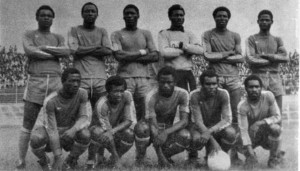 As for the team, the world knew only one player of the African champions – Jean Manga-Oungene. He was already 34 years old – too old to attract the interest of any European club, but he perhaps had the respected career on the African continent: this was his 4th international cup won with Canon. It was another player of this team to become a household name around the world – but in 1982. Canon was doing really well since 1970: 5 Cameroonian titles, 5 Cameroonian Cups, 3 times African club champions, one African Cup Winners Cup – and three continental cups in succession: Champions Cup in 1978, Cup Winners Cup in 1979, and again Champions Cup in 1980. Excellent record.
As for the team, the world knew only one player of the African champions – Jean Manga-Oungene. He was already 34 years old – too old to attract the interest of any European club, but he perhaps had the respected career on the African continent: this was his 4th international cup won with Canon. It was another player of this team to become a household name around the world – but in 1982. Canon was doing really well since 1970: 5 Cameroonian titles, 5 Cameroonian Cups, 3 times African club champions, one African Cup Winners Cup – and three continental cups in succession: Champions Cup in 1978, Cup Winners Cup in 1979, and again Champions Cup in 1980. Excellent record.
USA-Canada
USA – Canada: North American football was separable only at lower local levels. These championships were outside international interest and who played there is difficult to say. One may argue that popularity of football was gradually increasing. May be.
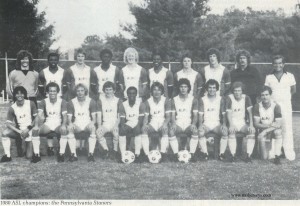 Pennsylvania Stoners – 1980 ASL champions. American Soccer League… in another country this league would have been second division. In USA/Canada it was separate entity of professional football and could be seen as second level only if money were better than in other leagues. Champions, indeed, but only NASL attracted interest.
Pennsylvania Stoners – 1980 ASL champions. American Soccer League… in another country this league would have been second division. In USA/Canada it was separate entity of professional football and could be seen as second level only if money were better than in other leagues. Champions, indeed, but only NASL attracted interest.
NASL was at very interesting point of its existence: there was illusion of stability. No new teams, no teams folding, no teams moving to another city. Foreign players were moving in – the biggest names of world football were playing in North America.
 Johann Cruijff joined Washington Diplomats – after he ‘retired’ not long ago. Everybody was here – old veterans, current stars, second-raters, unknown players, touring players, loaned players, temporary players, Europeans, Central and South Americans, Africans, Asians… and some North Americans. Under regulations, the teams had to field 3 domestic players in every match – the number was increased from the previous year by one. Care for local boys… many of them were naturalized, though. And North American clubs were never like the clubs anywhere else: they had only one professional team – no youth system. No wonder North American players were few and hardly good. Building a team was hardly a priority in NASL – although great coaches were hired as well as players, the emphasis was on individual names, so North American teams continued to be bizarre formations, mixing great stars with virtually anonymous teammates. The league and the franchise owners still believed that pouring money would eventually establish football as big North American sport – but it remained a novelty for most Americans and, most importantly, for the media, especially television. A crisis was already settling: the clubs spent too much without returns. Cruijff was not coming cheap – but in order to get crowds, tickets had to be cheap… forget about profit. NASL started the new decade optimistically on the surface, but the future was really bleak. Nothing helped – even the weird rules, which still gave 6 points for a win, 1 point for shoot-out win (there were no ties inNASL), and 1 point for each goal scored during regulation time up to 3 points per match. Foreign players new very well that North American football was not serious – they came for money and fun. Some, like George Best, loved the easy life, some ruined their careers, like Romero, some came to get some extra cash between seasons at home and were smart enough to look elsewhere for serious football, like Hugo Sanchez and Ruud Kroll. Even coaches had lazy view on North American football – Rinus Michels, for instance, was nothing like the severe and stubborn disciplinarian he was in Europe.
Johann Cruijff joined Washington Diplomats – after he ‘retired’ not long ago. Everybody was here – old veterans, current stars, second-raters, unknown players, touring players, loaned players, temporary players, Europeans, Central and South Americans, Africans, Asians… and some North Americans. Under regulations, the teams had to field 3 domestic players in every match – the number was increased from the previous year by one. Care for local boys… many of them were naturalized, though. And North American clubs were never like the clubs anywhere else: they had only one professional team – no youth system. No wonder North American players were few and hardly good. Building a team was hardly a priority in NASL – although great coaches were hired as well as players, the emphasis was on individual names, so North American teams continued to be bizarre formations, mixing great stars with virtually anonymous teammates. The league and the franchise owners still believed that pouring money would eventually establish football as big North American sport – but it remained a novelty for most Americans and, most importantly, for the media, especially television. A crisis was already settling: the clubs spent too much without returns. Cruijff was not coming cheap – but in order to get crowds, tickets had to be cheap… forget about profit. NASL started the new decade optimistically on the surface, but the future was really bleak. Nothing helped – even the weird rules, which still gave 6 points for a win, 1 point for shoot-out win (there were no ties inNASL), and 1 point for each goal scored during regulation time up to 3 points per match. Foreign players new very well that North American football was not serious – they came for money and fun. Some, like George Best, loved the easy life, some ruined their careers, like Romero, some came to get some extra cash between seasons at home and were smart enough to look elsewhere for serious football, like Hugo Sanchez and Ruud Kroll. Even coaches had lazy view on North American football – Rinus Michels, for instance, was nothing like the severe and stubborn disciplinarian he was in Europe.
 Rinus Michels at the helm of Los Angeles Aztecs – one look at the squad tells it all: hardly a team to his liking. So why bother? The rules practically qualified the team to the second stage anyway. In the next stage – direct eliminations – one may argue that Michels had to stand up, for Aztecs played against Washington Diplomats – Michels vs Cruijff, that is – but the argument is lame.
Rinus Michels at the helm of Los Angeles Aztecs – one look at the squad tells it all: hardly a team to his liking. So why bother? The rules practically qualified the team to the second stage anyway. In the next stage – direct eliminations – one may argue that Michels had to stand up, for Aztecs played against Washington Diplomats – Michels vs Cruijff, that is – but the argument is lame.
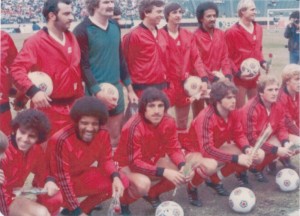 Washington Diplomats with Cruijff. So what? Aztecs eventually prevailed and Cruijff started a vacation. The Aztecs continued ahead and eliminated Seattle Sounders in the next round – only in North America a team can go ahead after winning 3-0 the first leg and losing 0-4 the second… but then Michels faced New York Cosmos and Hennes Weiswailer. The leading coaches of the 1970s, both lead Barcelona, blah, blah… Cosmos had the biggest names in NASL and Michels lost both legs. Vacation.
Washington Diplomats with Cruijff. So what? Aztecs eventually prevailed and Cruijff started a vacation. The Aztecs continued ahead and eliminated Seattle Sounders in the next round – only in North America a team can go ahead after winning 3-0 the first leg and losing 0-4 the second… but then Michels faced New York Cosmos and Hennes Weiswailer. The leading coaches of the 1970s, both lead Barcelona, blah, blah… Cosmos had the biggest names in NASL and Michels lost both legs. Vacation.
San Diego Sockers lost the other semi-final – or Conference championship, in NASL terms – to Fort Lauderdale Strikers. The Mexican stars Hugo Sanchez and Leonardo Cuellar played for the team a bit – both played in the Mexican championship in the same year, so it was a brief spell – get the cash and go back to Mexico. Some of their teammates were more involved with NASL – Volkmar Gross, who played UEFA Cup final a few years back, had no illusions about playing in Europe: too old by now and not a strong enough player anyway – North America was great. The Turk Yilmaz Orhan had no chance of playing for serious team in Europe. NASL was largely made of players like these two. Fort Lauderdale was not much different:
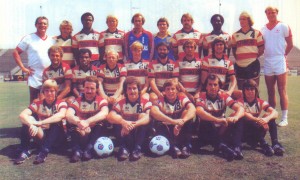 Take away Gerd Muller, Francisco Marinho, and Teofilo Cubillas and there would be nothing. Well, Francisco Marinho did not play at the big final – Jan van Beveren was the third big name by then, showing the handicaps of NASL vision fully: depending on few veterans was just enough to go all the way.
Take away Gerd Muller, Francisco Marinho, and Teofilo Cubillas and there would be nothing. Well, Francisco Marinho did not play at the big final – Jan van Beveren was the third big name by then, showing the handicaps of NASL vision fully: depending on few veterans was just enough to go all the way.
Soccer Bowl – the great trophy, the real trophy in the land,where virtually no team was left without winning something. But this was the championship duel – played in Washington, DC, on September 21 in front of 50, 768… fans? Observers? The number is misleading – great crowd, for sure, but accidental one. As for the date – it also spells out another chronic problem of North American football: the season ended just at the beginning of the season in Europe. The flock of part-timers hurried back to real football. Generously paid vacation was over until next year. The final opposed – on paper – the leaders of world football as known by then: Cosmos was coached by German – Hennes Weisweiler – and Strikers by Dutch – Cor van der Hart. A replay of 1974 World Cup final? You wish… there was obvious difference in class. Cosmos was if not he most professional team in the league, at least the richest and having the most famous squad as a result. Which made possible to field a decent team – there were enough players for that. Strikers mainly depended on old stars and enthusiasm. Not exactly a contest… Cosmos scored 3 in the second half of the final, Strikers – nil. To a point, it was World Cup 1974 showcase: Beckenbauer, Rijsbergen, Bogicevic, Chinaglia (Cosmos) and Muller and Auguste (Strikers). Eskandarian played at the 1978 World Cup. Cubillas – 1970 and 1978 World Cup. Two more former Dutch national team players for Strikers – Jan van Beveren and Lex Schoenmaker. Cosmos had much more to offer: the Paraguayan star Julio Cesar Romero, who was considered more talented than Maradona just a year ago, the Belgian star Francois van der Elst, who was instrumental for Anderlecht’s European conquests, and Roberto Cabanas, South American champion with Paraguay. Even the rule requiring 3 North Americans on the pitch did not bother Weisweiler – his were better than those playing for Fort Lauderdale. There were some people sitting on the bench – the 1970 World champion Carlos Alberto, Johan Neeskens… Cosmos won easily.
Fort Lauderdale Strikers – technically, 2nd in the 1980 NASL championship. May be disappointed, but considering the squad – a good season. May be not for some of the players, used to success, but what the hell. May be not so great for Gerd Muller – it was not exactly losing the championship to his buddy Franz Beckenbauer, but the boredom of easy American life in the South: Gerd Muller turned to drinking. Following George Best… but not Johan Neeskens, who turned to drugs.
 Cosmos – 4th title for them. The most successful NASL team and rightly so. Standing from left: David Brcic, Carlos Alberto, Jeff Durgan, Hubert Bierkenmeier, Wim Rijsbergen, Franz Beckenbauer, Vladislav Bogicevic, Andranik Eskandarian, Hennes Weisweiler – coach.
Cosmos – 4th title for them. The most successful NASL team and rightly so. Standing from left: David Brcic, Carlos Alberto, Jeff Durgan, Hubert Bierkenmeier, Wim Rijsbergen, Franz Beckenbauer, Vladislav Bogicevic, Andranik Eskandarian, Hennes Weisweiler – coach.
Crouching: Seninho, Rick Davies, François Van der Elst, Julio Cesar Romero, Giorgio Chinaglia, Roberto Cabanas, Angelo Di Bernardo, Bruce Wilson.
This is not even half the squad here – Cosmos clearly had the best players year in and year out. Actually, every next year the roster was getting more famous. New York Cosmos easily became famous outside North America, they toured a lot, and they built stable fan-base. But it was not enough… the club was losing money, like the rest of NASL clubs. Outside New York there was no much paying audience. The roster was very expensive. But it was perhaps the only NASL club managing to stay consistently strong. Franz Beckenbauer played his last North American season and Carlos Alberto decided to move to California, but new players were signed quickly to keep Cosmos at the top. However, this squad was perhaps the most famous team Cosmos had.
Mexico I Division
The Mexican championship continued running its peculiar mixed European-Northamerican formula. The 20 first division teams played twice against each other, as it is in Europe, but there was no one league table. The league was divided into 4 groups with their own tables, as North American leagues in any sport are usually organized. After every team played its 38 matches, the top two teams from each group moved to the next stage. As for relegation, the two teams with least points of those ending at the bottom of the group tables played a relegation play-off between themselves. The loser went down. The formula had a handicap in its design: it was possible that 3rd placed team in at least one group could have earned more points than some 2nd placed team, but was not going to proceed to the next stage. Also there was possible a 4th placed team to have fewer points than some of the last placed, but will keep its place in the league, because of finishing higher in its own group. Nothing like that happened this season – on the contrary: precisely two teams finished with least points and last in their own groups. As for those on top, the very same teams would have been at the top 8 positions in a normal league table – there was none lucky or unlucky. The divisions were quite refined: there was not even one club coming relatively close to the best – CD Guadalajara, 3rd in Group 2 lagged behind with the smallest difference and it was 3 points short of the record of 2nd placed Tampico. As for the largest difference, it occurred in Group 1, where second-placed Atlante was 15 points clear of the 3rd, Monterrey. At the bottom sunk Jalisco, Group 1, and Union de Curtidores, Group 2, both with 28 points. They were to face each other in the last effort to avoid relegation.
The first leg was played in Guadalajara, the home base of Jalisco, and they prevailed 2-1. Not a big cushion and the second match in Leon was difficult – once again, the home team won, but this time it was 3-1 victory. Just enough for Union de Curtidores to survive. The relegation play-off presents the confusing difficulties of understanding Mexican football in a nutshell: Union de Curtidores is an old club, founded in 1928. Jalisco – or rather Club Social y Deportivo Jalisco – were babies next to Curtidores: founded in 1970. But were they? That year either existent club or businessmen bought the old and quite successful in the past CD Oro, which was in financial crisis. Along with the club its franchise was acquired. The new concoction was named Club Social y Deportivo Jalisco, having the right to play professional football at the place of CD Oro. Thus, it was both new and old club at the same time and even its history was and is mixed with that of CD Oro – because of the continuation not of the club, but of the franchise. Usual case in Mexico… Guadalajara had a new club, without really changing the number of the clubs located in the city. Very likely the owners were ambitious, but as often happens with such projects, difficulties were quick to emerge: one typical problem is fan base. Guadalajara, having a few old and well established clubs, is hardly the place where a new club could attract immediate and massive following. Traditional clubs are also having enough money to keep at least at the same level of the newcomers. Even quick success could be perilous for a new club affronted by strong competition. Very likely Jalisco was not in great shape by the end of the 1970s, although they tried hard: before the start of the season they hired the Argentine star of Atletico (Madrid) Ruben Ayala. The ‘Mouse’ was getting old, but he was a big name – unfortunately, the neighbours had no difficulties getting good foreign players, so Jalisco hardly had an advantage. And they were relegated at the end.
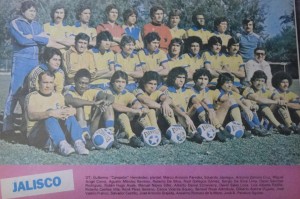 Jalisco going down to Second Division – a move, usually signaling the end of such new clubs. Shocking experience for Ruben Ayala (second from left at the top row), used to playing for the title, but he left immediately after the end of the season.
Jalisco going down to Second Division – a move, usually signaling the end of such new clubs. Shocking experience for Ruben Ayala (second from left at the top row), used to playing for the title, but he left immediately after the end of the season.
Of course, the relegation play-off was small affair, compared to the race for the title – the 8 teams reaching the next stage were divided in 2 groups, where the participants played twice against each other and the group winners moved to the championship final. All or nothing, all teams started with clean sheets, from zero, therefore, anything was possible. Of the first phase of the championship, perhaps Deportivo Neza deserves mentioning:
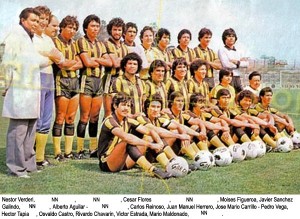 The kings of ties – Deportivo Neza tied 20 of their 38 matches. They qualified to the next round thanks to that.
The kings of ties – Deportivo Neza tied 20 of their 38 matches. They qualified to the next round thanks to that.
Unless a full unregulated draw took place, there is no reason for the making of the new groups: Group 1 consisted of U.A.N.L. (or Tigres, Monterrey, 2nd in original Group 4), America (Mexico City, 1st in Group 3), U.N.A.M. (or Pumas, Mexico City, 1st in Group 2), and Club de Futbol Zacatepec (Zacatepec, 1st in Group 4). Cruz Azul (Mexico City, 1st in Group 1), Atlante (Mexico City, 2nd in Group 1), Tampico (2nd in Group 2), and Deportivo Neza (2nd in Group 3) made Group 2. Three original group winners were Group 1, which, at a glance, favoured the single group winner in Group 2, which had to play against theoretically weaker opponents. Then, if earlier performance was indicative, the final was already known: 2 teams dominated the first stage – Cruz Azul and America. America finished with 57 points, Cruz Azul – with 55. The next best team – Atlante – earned only 49. But since no points were carried from the first stage, all teams were equal and may be those saving their strength for the finals had better chance than those dominating the first stage. The second stage did not really went into wild surprises – except for one team, the rest played as they did earlier.
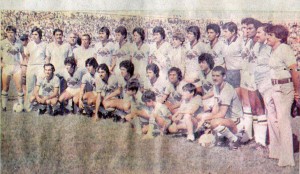 Tampico finished with the worst record among the top 8: they got only 4 points. Nothing really shaking the Universe: if there was a ‘normal’ final table after the first stage, they would have been 7th. Weaker than the rest and never mind the menacing crab with big claws on their shirts.
Tampico finished with the worst record among the top 8: they got only 4 points. Nothing really shaking the Universe: if there was a ‘normal’ final table after the first stage, they would have been 7th. Weaker than the rest and never mind the menacing crab with big claws on their shirts.
The truly unlucky team this season was Atlante.
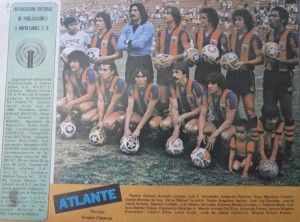 Atlante finished 2nd in their preliminary group – 6 points behind Cruz Azul. But they had the 3rd strongest point record in the league and also the 3rd strongest strikers. They were the only team scoring 2-digit number of goals in the second stage – 12 – but… 2 wins, 2 ties, and 2 losses gave them no chance to play the final. Once again they finished behind Cruz Azul. Atlante, twice second this season, had to wait for better next season.
Atlante finished 2nd in their preliminary group – 6 points behind Cruz Azul. But they had the 3rd strongest point record in the league and also the 3rd strongest strikers. They were the only team scoring 2-digit number of goals in the second stage – 12 – but… 2 wins, 2 ties, and 2 losses gave them no chance to play the final. Once again they finished behind Cruz Azul. Atlante, twice second this season, had to wait for better next season.
On a better note finished U.N.A.M.
Bora Milutinovic made them champions the previous year and his work was going well. The team was good – but it was a club not yet used to winning. Pumas played well in second stage, but were unable to win and score – they ended with record number of ties: 4. They also scored the least goals – 3. With Hugo Sanchez leading the attack… But very likely nobody was disappointed: Pumas was just beginning their strong years. It was a stable season, the team had potential, so the coach.
A relative surprise was the play of America – the strongest team in the first stage.
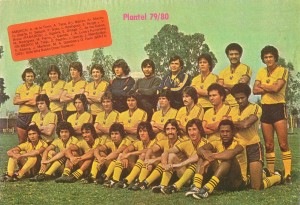 Traditional powerhouse, they were not just favourites on reputation, but really were head and shoulders above all teams, save Cruz Azul, at first. A squad full of Mexican national team players. Add the Brazilian star Fumanchu, who is relatively unknown outside South America, but is well remembered name there. But America kind of stumbled in the second stage – not a big fall from grace, but just a bit misstepping. 2 wins, 2 ties, 2 losses – they could have been first only on goal-difference and nothing else. But there was a team with 7 points and America finished 2nd and exited the race for the title.
Traditional powerhouse, they were not just favourites on reputation, but really were head and shoulders above all teams, save Cruz Azul, at first. A squad full of Mexican national team players. Add the Brazilian star Fumanchu, who is relatively unknown outside South America, but is well remembered name there. But America kind of stumbled in the second stage – not a big fall from grace, but just a bit misstepping. 2 wins, 2 ties, 2 losses – they could have been first only on goal-difference and nothing else. But there was a team with 7 points and America finished 2nd and exited the race for the title.
America was bested by the only visibly improving team in the second stage – U.A.N.L. was the team with the lowest record among the best of the first stage. Back then they earned just 40 points. 17 less than America! In a normal league, they were to take 8th place without any chance even for dreaming of a title. May be they preserved their strength at first, may be they got inspired in the second stage, may be they made fewer mistakes than the others, but they finished 1st in Group 1 with 7 points. Leaving America sulking behind.
Cruz Azul wee 1st in Group 2 – just like they were first in the their first stage group. Just like earlier in the season, they left nothing to chance – theirs was the best record in the second stage: 8 points. 4 wins and 2 losses. Obviously, attacking minded and determined team. If U.A.N.L. proved the wisdom of preserving form for the time when it really mattered, Cruz Azul proved the other wisdom – that a strong team is strong consistently. If you start winning early, you will win to the end. Nothing can be really concluded from such oppositional approaches.
Anyhow, the title was contested between Cruz Azul and A.U.N.L.. The first leg was in Monterrey and on home turf Tigres… lost 0-1. Looked like the final was over – winning away. Cruz Azul made the second leg a mere formality. Wrong! Tigres came back and fought to the end. Cruz Azul managed to tie their home game 3-3, thanks to the goals of Adrian Camacho and Rodolfo Montoya (2). Montoya was the big hero – he scored the winning goal in Monterrey too. The fans hardly minded that their team did not win in front of them, because it was enough for the title – the final victory!
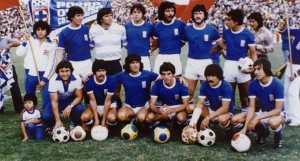 7th title for Cruz Azul, all won after 1968. The 1970s decade is the most successful period in the history of the club, but at the real time nobody would have imagined that. Rather, it looked like Cruz Azul was going to win and win – they finished great decade and started a new one triumphant. Yet, to a point, Cruz Azul was unlikely champions: they had strong squad, but somewhat fell short, compared to America, Atlante, even U.N.A.M. Pumas. Most of the best Mexican players belonged to the competition. Even the foreigners playing for Cruz Azul were not well known. The scoring heroes of the final against U.A.N.L. Tigres were rather ordinary players – neither Montoya, nor Camacho became Mexican stars. Of course, Cruz Azul had strong players – Guillermo Mendizabal, Gerardo Lugo Gomez, Horacio Lopez Salgado, Ignacio Flores – who were current or former members of the national team, but all of them trailed in the shadow of Hugo Sanchez, Thomas Boy, Leonardo Cuellar, to mention a few. Salgado was at the end of his playing career, Flores did not play for Mexico after 1981, neither did Mendizabal. Gomez was occasional national team player anyway. Of similarly low standing were the foreign players as well – Carlos Jara Saguiar played now and then for his native Paraguay, but he was the only foreigner coming close to a national team player. The goalkeeper Jose Miguel Marin played twice for Argentina in the almost forgotten by now 1971. His compatriots Miguel Angel Cornero and Jose Luis Ceballos never donned the Argentine jersey – and were not well known names in their home country. Cruz Azul compensated the relative lack of great individuals by well-oiled squad, which played together for a long time and new each other perfectly. Marin joined the club in 1971, Saguiar came in 1975, Cornero – in 1977, but he already was playing in Mexico for America. Ceballos was the latest arrival – he came from Chilean Everton in 1978. Loyal to the club players – that seemed to be the secret of champions. Everybody was playing for years – Ignacio Flores, for instance, played only for Cruz Azul: his career started in 1972 , ending in 1990. With a good coach, such stable and experienced team was able to achieve quite a lot – and they had good coach: Ignacio Trelles. Like his players, he worked for Cruz Azul a long time – from 1977 to 1982. The only problem with such kind of a team is the future: inevitable aging of the whole bunch. But future was not a problem yet – the present was great: one more title at hand!
7th title for Cruz Azul, all won after 1968. The 1970s decade is the most successful period in the history of the club, but at the real time nobody would have imagined that. Rather, it looked like Cruz Azul was going to win and win – they finished great decade and started a new one triumphant. Yet, to a point, Cruz Azul was unlikely champions: they had strong squad, but somewhat fell short, compared to America, Atlante, even U.N.A.M. Pumas. Most of the best Mexican players belonged to the competition. Even the foreigners playing for Cruz Azul were not well known. The scoring heroes of the final against U.A.N.L. Tigres were rather ordinary players – neither Montoya, nor Camacho became Mexican stars. Of course, Cruz Azul had strong players – Guillermo Mendizabal, Gerardo Lugo Gomez, Horacio Lopez Salgado, Ignacio Flores – who were current or former members of the national team, but all of them trailed in the shadow of Hugo Sanchez, Thomas Boy, Leonardo Cuellar, to mention a few. Salgado was at the end of his playing career, Flores did not play for Mexico after 1981, neither did Mendizabal. Gomez was occasional national team player anyway. Of similarly low standing were the foreign players as well – Carlos Jara Saguiar played now and then for his native Paraguay, but he was the only foreigner coming close to a national team player. The goalkeeper Jose Miguel Marin played twice for Argentina in the almost forgotten by now 1971. His compatriots Miguel Angel Cornero and Jose Luis Ceballos never donned the Argentine jersey – and were not well known names in their home country. Cruz Azul compensated the relative lack of great individuals by well-oiled squad, which played together for a long time and new each other perfectly. Marin joined the club in 1971, Saguiar came in 1975, Cornero – in 1977, but he already was playing in Mexico for America. Ceballos was the latest arrival – he came from Chilean Everton in 1978. Loyal to the club players – that seemed to be the secret of champions. Everybody was playing for years – Ignacio Flores, for instance, played only for Cruz Azul: his career started in 1972 , ending in 1990. With a good coach, such stable and experienced team was able to achieve quite a lot – and they had good coach: Ignacio Trelles. Like his players, he worked for Cruz Azul a long time – from 1977 to 1982. The only problem with such kind of a team is the future: inevitable aging of the whole bunch. But future was not a problem yet – the present was great: one more title at hand!
Mexico II Division
Going north to Mexico. The mixture of European and American regulations make difficult long-term following of the country’s championships,especially the Second Division ones: too many changes too often. Since the clubs were franchises, they moved from place to place, changing their names as well. This season the teams reaching the final of the Second Division championship were Osos Grises and Atletas Campesinos. Neither name makes sense today. Osos Grises was not even the real name of the club – it was Club Deportivo del Estedo de Mexico, founded in 1976 in the city of Toluca. Young club, surely, and seemingly not just a former club moved to Toluca. They climbed rapidly from the lower levels of Mexican football to the Second Division, aiming even higher. As for the name, they were quickly nicknamed ‘Osos Grises’, because of their gray jerseys. The nickname stuck and practically replaced the real name even in official records. In the first leg of the final the new club seemed ready to go further – they managed a 0-0 tie away and needed only a small victory at home. Easy… but it was not: Atletas Campesinos won in Toluca – 2-1 – and became not only champion of Second Division, but, more importantly, promoted to top level.
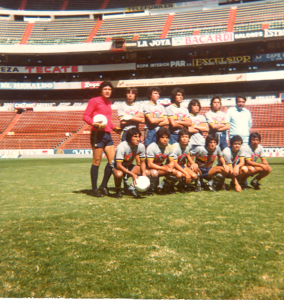 Osos Grises reached their highest success in their, as it turned out, very brief history: the club disappeared soon after that final.
Osos Grises reached their highest success in their, as it turned out, very brief history: the club disappeared soon after that final.
Only one club was promoted to First Division and naturally it was the champions of Second Division: Atletas Campesinos were the lucky guys.
The club hailed from Queretaro, but it was neither new one, nor the first team representing the city. Yet, it was… for it was found in 1977. At that time a businessman, named Armando Presa, bought two local clubs – Estudiantes and Gallos Blancos (the White Roosters) – and amalgamated them into a club freshly named Atletas Campesinos. So, the birthdate of the club is 1977 and thus its climb to the top level of Mexican football was even quicker than the similar one of Osos Grises. But… at least Gallos Blancos was older club and a franchisee: to a point, Atletas Campesinos ride on the back of the Gallos Blancos franchise. Which at the end affects the later story of the club founded in 1977 – it had short existence, but not a final date. Eventually, as a franchise, it moved to another city under new name. Eventually, Gallos Blancos re-emerged and went through its newer transitions. Let it be like that: the club died as a club, but remained as a franchise. There was even one more problem: the logo. The tractor was seen as an hidden advertisement, prohibited by the rules of the Mexican Federation, although the picture does not represent neither manufacturer, nor model. In the later transformations of the club the colours were restored, at least for awhile, but the logo had to go. In 1979-80 problems did not cloud the horizon yet – it was happy time: the club won promotion and became popular, for it suddenly gave the city of Queretaro a first division team. People loved it – the reason that the club has something of a cult status today: people fondly remember the name.
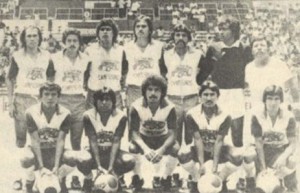 Champions of Second Division – after stumbling at home, Atletas Campesinos won 2-1 away and got promoted. Sky was the limit – so far, money were not a problem and the success was due to a coach with a famous name.
Champions of Second Division – after stumbling at home, Atletas Campesinos won 2-1 away and got promoted. Sky was the limit – so far, money were not a problem and the success was due to a coach with a famous name.
 None other but Antonio Carbajal lead Atletas Campesinos to victory – the man, whose record 5 World Cup finals was matched only by the end of the 20th century, but remains unbeaten. Unfortunately, winning Second Division was the best achievement – soon financial troubles emerged and although a great star was added to the team in 1981, Atletas Campesinos suffered in First Division – and in 1982 there was no more such club: the franchise was sold. Nothing terrible was detected in 1980, though: it was fantastic season of 3-years old club.
None other but Antonio Carbajal lead Atletas Campesinos to victory – the man, whose record 5 World Cup finals was matched only by the end of the 20th century, but remains unbeaten. Unfortunately, winning Second Division was the best achievement – soon financial troubles emerged and although a great star was added to the team in 1981, Atletas Campesinos suffered in First Division – and in 1982 there was no more such club: the franchise was sold. Nothing terrible was detected in 1980, though: it was fantastic season of 3-years old club.
Venezuela
Venezuela – arguably, the least complicated South American championship: 11-team professional league. No relegation. The first 6 teams go to final tournament after the standard first phase. The bottom five go to vacation. Eventual promotion from the lower level – very likely depending on financial requirements. Something no other South American country had: a Cup tournament as played in Europe – a separate tournament, not attached in some way to the championship. Atletico Zamora and Valencia FC competed at the final – Zamora won.
 Atletico Zamora – the 1980 Cup winners of Venezuela. Some unknown Brazilians helped the club to the trophy.
Atletico Zamora – the 1980 Cup winners of Venezuela. Some unknown Brazilians helped the club to the trophy.
The Second Level championship opposed Union Deportiva Valera to Falcon FC (Coro). Falcon FC won. They won in 1979 as well, but this victory was different – they were promoted to First Division. Curiously, the other first division team from Coro was also Falcon – but Atletico Falcon. A derby between birds next year.
The first phase of the first division championship was only important for deciding the 6 teams going to the final tournament. Deportivo Portugues was the hopeless outsider – they got only 9 points and scored 8 goals in 20 championship matches. But nothing to fear – no team faced relegation. Deportivo Galicia made another record – they tied 12 games, a league record. However, only Deportivo Portigues won less matches than them and Deportivo Galicia did not reach the final stage: they finished 8.
 Deportivo Galicia – masters of ties.
Deportivo Galicia – masters of ties.
The unlucky club was Deportivo Tachira – they finished 7th with 21 points: if they had one point more, they were to play the final tournament, for they had better goal-difference than 2 of the finalists.
But they lacked that one point and exited the championship with only one thing worth notice: lovely kit.
The lucky 6 were equal at this stage: 4 teams ended with 22 points – Deportivo Lara, Estudiantes de Merida, ULA Merida, and Atletico Zamora. Above them were Valencia FC with 25 points and Portuguesa FC with 29. Everything the top clubs got from the first stage was bonus points – Valencia 1 point for finishing 2nd, and Portuguesa – 2 points for finishing first. At this time Portuguesa appeared head and shoulders above the competition and the likeliest champion: they lost just a single match, they won most games, and received only 9 goals. But 2-staged championships are tricky: there are always teams playing just enough to qualified for the finals, preserving their strength for what really matters.
The final stage had one and only favourite and it was not Portuguesa. Atletico Zamora seemingly did not care much at this stage – they did not win even one match, finishing last with 5 ties and 5 losses. Like the first stage, 4 teams were more or less equal, but there was interesting development: except the champions, only one team finished with positive goal-difference. And it was not a medalist:
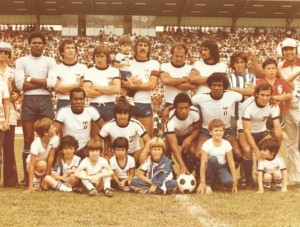 ULA – Universidad Los Andes (Merida) – finished with 12:11 goal-difference, but with 9 points, they were 4th in the final table.
ULA – Universidad Los Andes (Merida) – finished with 12:11 goal-difference, but with 9 points, they were 4th in the final table.
Valencia FC was 3rd with 11 points – they would have been at the same place even without their bonus point, carried from the opening stage.
Portuguesa FC (Acarigua) was nothing much at this stage – they finished 2nd and like Valencia FC the 2 bonus points from the first stage did not matter, but they were not contenders. Supreme in the opening stage of the championship, now they were only distant second – 3 wins, 5 ties, 2 losses, and 9:10 goal-difference. Valencia finished with 9:11 goal-difference – medalists with negative goal-difference occurred now and then in football history, but it was just one such anomaly in a final table: here 2 of the three top teams finished with negative goal-difference. Perhaps unique event.
Which, of course, did not bother the strongest team at the slightest – Estudiantes de Merida soared at the final stage, leaving the rest far behind. 8 wins, 1 tie, 1 loss, 19:7 goal-difference. Hard to believe when looking at the final table of the first stage – and perhaps that was the trick: Estudiantes saved their strength for the final, fooling the competition with their originally mediocre performance. When it mattered, they were just too strong.
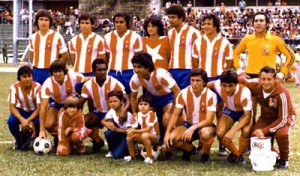 Champions in a grand way. Historic victory too – the first title for the club.
Champions in a grand way. Historic victory too – the first title for the club.
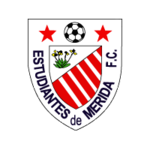 Estudiantes were formed in 1971 and 10 years later celebrated their first title – wonderful achievement for a young club, which was not even the number one club in their home town: ULA was. There was even a connection between the two clubs – it seemed that Estudiantes was something like farm-club to ULA, at least if one considers the people involved with organizing and running the clubs, and the obvious relation with the University Los Andes. Anyhow, ULA finished 4th and Estudiantes were the new champions of Venezuela.
Estudiantes were formed in 1971 and 10 years later celebrated their first title – wonderful achievement for a young club, which was not even the number one club in their home town: ULA was. There was even a connection between the two clubs – it seemed that Estudiantes was something like farm-club to ULA, at least if one considers the people involved with organizing and running the clubs, and the obvious relation with the University Los Andes. Anyhow, ULA finished 4th and Estudiantes were the new champions of Venezuela.
Ecuador
The Ecuadorian championship needs its own note on the formula – like most South American countries, it had two stages. The 10-team league played twice identical standard league championship – the top three teams of each one qualified to the finals. But the bottom two teams were relegated and replaced with the corresponding winners of the Second Division. Thus, the country effectively had two championships in a year as far as relegation-promotion was concerned. Similarly to many countries around the world, the strongest football was concentrated in few cities: the 1980 season started with 4 teams from the capital, Quito, 3 from Guayaquil, and Manta, Cuenca, and Ambato completed the league. La primera etapa was won by Universidad Catolica (Quito) with 21 points. One point below finished Tecnico Universitario (Ambato), 2nd, and Barcelona (Guayaquil), 3rd, both with 20 points. These three qualified to the final stage, awarded with bonus points – 3 for the first, 2 for the second, and 1 for the third. If anything, La primera etapa did not have a team above the rest: all top three teams lost 5 out of the total 18 matches they played. 4 clubs finished with 17 points – the unfortunate 9th finisher had only 4 points less the the winners. Deportivo Cuenca (Cuenca) was the outsider – they earned only 14 points and were relegated. Manta (Manta) was relegated because of worse goal-difference, but they won 8 of their 18 championship matches – the only other team with the same number was Universidad Catolica, the stage winners. Meantime LDU (Cuenca) and Deportivo Quito (Quito) won the first stage of the Second Division and were promoted.
La segunda etapa produced different winner – El Nacional (Quito) with 24 points. They finished 7th in the first stage, so it was quite an improvement. Barcelona was second thanks to better goal-difference and America (Quito) was 3rd. Both teams finished with 22 points. The newcomer LDU (Cuenca) finished last with 13 points. The second relegated team was again decided by goal-difference, but it was interesting outsider: Deportivo Quito survived at the expense of Emelec ( Guayaquil).
 Emelec, one of the best known Ecuadorian clubs, one of the most successful, the traditional powerhouse, suddenly had a weak season and instead of going up, plummeted down to second division football. They and LDU (Cuenca) were to be replaced in the next year by the winners of the second division second stage – LDU (Portoviejo) and Deportivo Cuenca (Cuenca).
Emelec, one of the best known Ecuadorian clubs, one of the most successful, the traditional powerhouse, suddenly had a weak season and instead of going up, plummeted down to second division football. They and LDU (Cuenca) were to be replaced in the next year by the winners of the second division second stage – LDU (Portoviejo) and Deportivo Cuenca (Cuenca).
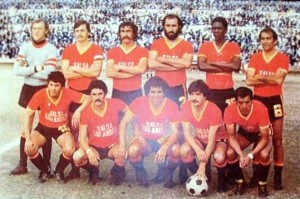 Deportivo Cuenca started the 1980 season in First Division and was going to start 1981 again in First Division.
Deportivo Cuenca started the 1980 season in First Division and was going to start 1981 again in First Division.
So much about the bottom – the top still had to play. The final stage consisted of the top three teams of each preliminary championships. Every team carried bonus points, depending on their position in the preliminary tables. Since Barcelona finished 3rd and 2nd in the two earlier championships, they started the final stage with 3 points – like the winners. They were the only club finishing among the top three in the both stages, thus reducing the ideal number of the finalists from 6 to 5. Once again the final tournament was played as standard league: every team played twice against all others. El Nacional was the weakest finalist – they did not win even one match. Three ties and 3 bonus points placed them 5th , 3 points behind the 4th. America ended next to last with 9 points – they were the 3rd strongest team at the final, earning 8 points, but had only 1 bonus point, and that decided their final position. Universidad Catolica apparently exhausted their strength in the opening stage – they won 2 matches, lost 2, and tied 4 at the final tournament – way too little for anything but 3rd place and that thanks to their 3 bonus points. Bonus points decided the championship: Tecnico Universitario was the strongest among the finalists – 5 wins, 1 tie, and 2 losses. But their 11 points, plus 2 bonus points, equaled the record of Barcelona, which earned 10 points at the final stage and had 3 bonus points. Goal-difference favoured no club – both leaders finished with +3. The title was decided by more goals scored… Tecnico Universitario scored 11 at the final stage – Barcelona scored 12 and grabbed the title.
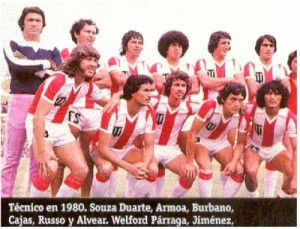 Tecnico Universitario (Ambato) had both great and unfortunate season – they lost the title because of one goal they did not score, yet, they got the second Ecuadorian spot in Copa Libertadores.
Tecnico Universitario (Ambato) had both great and unfortunate season – they lost the title because of one goal they did not score, yet, they got the second Ecuadorian spot in Copa Libertadores.
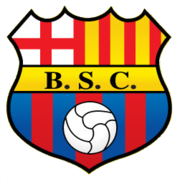
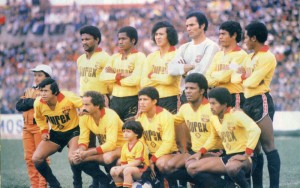 May be lucky at the end, but Barcelona was most deserving, if one looks at the whole season – they were consistently strong, finishing gradually higher at every next stage – 3rd, 2nd, and when it mattered most – 1st. The squad was nothing much by international standards and could not be, considering the level of Ecuadorian football at the time. As in all smaller South American countries, foreigners were the main force – but they were not famous stars. Brazilians were the imports here – nobody heard of two of them, Nei ( or Ney – real name: Dirnei Celestino, a prolific scorer) and Escurinho, but the third one must be pointed out: the veteran goalkeeper Manga. Despite the stigma of having been a member of the 1966 World Cup Brazilian squad – ‘the worst of all time’ – he was always a winner. After conquering the world with Nacional (Montevideo) at the beginning of the 1970s, winning the Brazilian title with Internacional (Porto Alegre) in the mid-70s, now he was starting a new decade with a title. Manga was 43 years old! He arrived from Gremio (Porto Alegre). Years back he played with much younger Escurinho (b. 1950) for Inter (Porto Alegre). Like Manga, Escurinho was new recruit, coming from Coritiba (Curitiba). The 4th Brazilian was illustrious striker, who arrived from Colombian Independiente Medellin earlier than Manga and Escurinho – in 1977. His name is… tough.
May be lucky at the end, but Barcelona was most deserving, if one looks at the whole season – they were consistently strong, finishing gradually higher at every next stage – 3rd, 2nd, and when it mattered most – 1st. The squad was nothing much by international standards and could not be, considering the level of Ecuadorian football at the time. As in all smaller South American countries, foreigners were the main force – but they were not famous stars. Brazilians were the imports here – nobody heard of two of them, Nei ( or Ney – real name: Dirnei Celestino, a prolific scorer) and Escurinho, but the third one must be pointed out: the veteran goalkeeper Manga. Despite the stigma of having been a member of the 1966 World Cup Brazilian squad – ‘the worst of all time’ – he was always a winner. After conquering the world with Nacional (Montevideo) at the beginning of the 1970s, winning the Brazilian title with Internacional (Porto Alegre) in the mid-70s, now he was starting a new decade with a title. Manga was 43 years old! He arrived from Gremio (Porto Alegre). Years back he played with much younger Escurinho (b. 1950) for Inter (Porto Alegre). Like Manga, Escurinho was new recruit, coming from Coritiba (Curitiba). The 4th Brazilian was illustrious striker, who arrived from Colombian Independiente Medellin earlier than Manga and Escurinho – in 1977. His name is… tough.
Vitor Epanor da Costa Filho was born in 1949 and played a bit at home, but really made his name abroad – mostly playing in Colombia. There his name was slightly changed and never really stabilized: he was called Victor Ephanor or Victor Epanhor. Never mind, he scored goals and plenty of them.
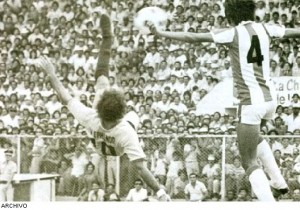 Some of Ephanor’s goals were spectacular – no wonder he became a legend in Colombia and Ecuador. Misterious name, yet Ephanor is less of a mystery than his new teammates – usually Manga and Escurinho are listed as Barcelona players from 1981 and 1980 is given as the year they played fro their former Brazilian clubs – but Ecuadorian statistics list them as Barcelona players for 1980 season. May be they started the year in Brazil and finished in Ecuador? Who knows.
Some of Ephanor’s goals were spectacular – no wonder he became a legend in Colombia and Ecuador. Misterious name, yet Ephanor is less of a mystery than his new teammates – usually Manga and Escurinho are listed as Barcelona players from 1981 and 1980 is given as the year they played fro their former Brazilian clubs – but Ecuadorian statistics list them as Barcelona players for 1980 season. May be they started the year in Brazil and finished in Ecuador? Who knows.
Four good Brazilians plus few Ecuadorians, the best of whom perhaps was Juan Madrunero.
 Juan Madrunero – arguably, the best Ecuadorian midfielder of the 1970s.
Juan Madrunero – arguably, the best Ecuadorian midfielder of the 1970s.
By all accounts – strong squad. At least by Ecuadorian measures – hence, the great season and the 6th title for Barcelona. Their first since 1971 – excellent beginning of new decade.
Bolivia
Bolivia. The only country with regular, uncomplicated championship in South America this year. The 14-team league had representatives of only 6 cities – La Paz and Santa Cruz had 4 teams each, Cochabamba – 3, and Oruro, Potosi, and Sucre – 1 each. Below them was a wider tournament was played – a second level championship, which winner was promoted to the top professional league. As for the first league, perhaps the most impressive thing was high scoring: at that time scoring rapidly declined everywhere, so to have 3.79 goal-average was nice. The numbers, however, were not because fantastic football was played in Bolivia, but because most clubs were weak.
 Independiente Petrolero (Sucre) won the second level championship and was promoted. For the first time in their history they were going to play first division football – naturally, wonderful achievement, especially because Independiente Petrolero did better than their city rivals Stormers. As it happened, they were taking their place.
Independiente Petrolero (Sucre) won the second level championship and was promoted. For the first time in their history they were going to play first division football – naturally, wonderful achievement, especially because Independiente Petrolero did better than their city rivals Stormers. As it happened, they were taking their place.
Stormers, an old and occasionally successful club, had very bad season – and not only season: it was more or less the end of them. The club never really recovered, no doubt the key reason was lack of money.
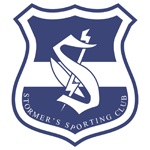 Stormers – or Stormer’s Sporting Club, as it is the full name, corrupted with time to Stormers – were pathetic outsiders this season. They won 2 matches, tied 2 , and lost 22. Their defense was really nothing – in 26 championship matches they received 103 goals. Memorable… on the negative side of records. Stormers were so bad, no other club of top flight had to fear relegation. But with Stormers down, Sucre suddenly was coming to the sad moment of not having first division team… luckily, Independiente Petrolero won promotion.
Stormers – or Stormer’s Sporting Club, as it is the full name, corrupted with time to Stormers – were pathetic outsiders this season. They won 2 matches, tied 2 , and lost 22. Their defense was really nothing – in 26 championship matches they received 103 goals. Memorable… on the negative side of records. Stormers were so bad, no other club of top flight had to fear relegation. But with Stormers down, Sucre suddenly was coming to the sad moment of not having first division team… luckily, Independiente Petrolero won promotion.
Even with an outsider, the first division was divided in three different groups: lowly teams at the bottom, quite below the rest – Independiente Unificada ( Potosi) – 13th, Always Ready (La Paz) – 12th, and Aurora (Cochabamba) – 11th. Above them was slightly better group – Real (Santa Cruz), San Jose (Oruro), Guabira (Santa Cruz), and Municipal (La Paz).
 Guabira (Santa Cruz) – a typical smallish Bolivian club. 8th this year. More then half of the league was quite weak, but even those above them were not particularly great. Oriente Petrolero (Santa Cruz), Blooming (Santa Cruz), and Bolivar (La Paz) were clearly stronger than most of the league, but not for a minute they challenged the top league spots.
Guabira (Santa Cruz) – a typical smallish Bolivian club. 8th this year. More then half of the league was quite weak, but even those above them were not particularly great. Oriente Petrolero (Santa Cruz), Blooming (Santa Cruz), and Bolivar (La Paz) were clearly stronger than most of the league, but not for a minute they challenged the top league spots.
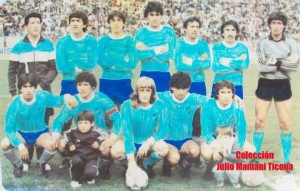 Bolivar – 4th this year, which amounted to very weak season for them. Bronze medals were way out of their reach – 4 points away at the end. Bolivar had the second best scoring record, though – 68 goals.
Bolivar – 4th this year, which amounted to very weak season for them. Bronze medals were way out of their reach – 4 points away at the end. Bolivar had the second best scoring record, though – 68 goals.
Two clubs fought for 2nd and 3rd place – an important battle, because the 2nd in the final table was getting the second Bolivian spot in Copa Libertadores. One point decided the lucky team.
 Petrolero (Cochabamba) lost the battle and finished with bronze, but they had curious season: apparently, their approach was defensive. They lost only one match – no other club matched their record – but tied also a record number of games: 12.
Petrolero (Cochabamba) lost the battle and finished with bronze, but they had curious season: apparently, their approach was defensive. They lost only one match – no other club matched their record – but tied also a record number of games: 12.
 The Strongest (La Paz) prevailed in the battle with Petrolero thanks to winning – they won 17 matches and eventually ended one point better than their rivals. However, 2nd place was hardly a success for a club used to trophies and this year they never came near the leaders. There was a single club dominating the championship: Jorge Wilstermann. Usual suspects, of course, but they were overwhelmingly strong. 22 wins, 2 ties, and 2 losses. 75-14 goal-difference – best strikers and best defenders. The Strongest finished 7 points behind – Jorge Wilstermann had no rival at all.
The Strongest (La Paz) prevailed in the battle with Petrolero thanks to winning – they won 17 matches and eventually ended one point better than their rivals. However, 2nd place was hardly a success for a club used to trophies and this year they never came near the leaders. There was a single club dominating the championship: Jorge Wilstermann. Usual suspects, of course, but they were overwhelmingly strong. 22 wins, 2 ties, and 2 losses. 75-14 goal-difference – best strikers and best defenders. The Strongest finished 7 points behind – Jorge Wilstermann had no rival at all.
 Solid champions, one more title going to Cochabamba. 7th title and a period called by the club ‘the third golden era’. A short ‘era’ it may have been, but success is success and this was the first title Jorge Wilstermann won since the Bolivian league became fully professional.
Solid champions, one more title going to Cochabamba. 7th title and a period called by the club ‘the third golden era’. A short ‘era’ it may have been, but success is success and this was the first title Jorge Wilstermann won since the Bolivian league became fully professional.
